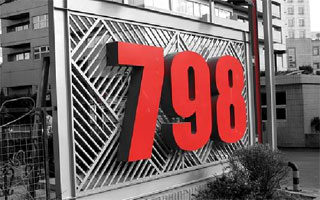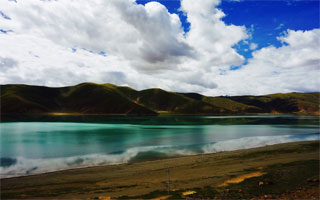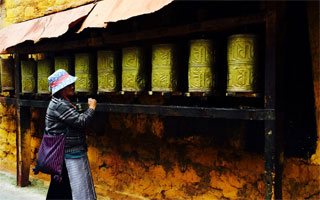(B=breakfast, L=lunch, D=dinner)
DAY 1 Beijing Airport transfer + Tianmen Square
Meet you at the Capital Airport. Today we will drive to Tian'anmen Square, which is the biggest central square in the world and is located in the center of the Beijing city. Here you could see the Monument to the People's Heroes, Great Hall of the People, Mao Zedong Mausoleum and the national flag raising and lowering ceremony. Thousands of people come to the Square every day. It is the must place to visit in Beijing City. And then take you to Hotel for rest. (We could also make changes of today's arrangements according to your flight schedule, as we think you need to adjust to the Jet Lag).
DAY 2 Summer Palace + Forbidden City + 798 Art Area + Peking Opera (L)
After breakfast drive to visit the Summer Palace, one of the best preserved summer resort for royal family. After lunch we will visit Forbidden City, the symbol of China, also called Gu Gong. It was the imperial palace during the Ming and Qing dynasties. Continue to explore the 798 Art Zone. 798 was a former electronic factory complex of unique architectural styles. Nowadays it's Beijing's most famous art zone housing contemporary art galleries and studios. Then back to the hotel for rest.
DAY 3 Beijing Panda + Lhama Temple + Confucius Temple + Hutong Tour + Make Chinese dumplings + Lotus Market (L)
Today we will visit Beijing Zoo, Lhama Temple, Confucius Temple, Hutong Tour and Lotus Market. The Lhama Temple, also called Yonghe Lamasery, is the best-preserved lamasery in existence in China today. It was first established during the Qing Dynasty as the residence of Emperor Yongzheng when he was just a prince, and it was also the birthplace of Emperor Qianlong, the son of Emperor Yongzheng. Confucius temple, it consists of four courtyards. The main structures include Xianshi Gate , Dacheng Gate , Dacheng Hall and Chongshengci. Hutong has a long history in Beijing. We will enjoy our lunch in hutong and have the opportunities to learn how to make Chinese dumplings. As the Forbidden City is the symbol of China's royal family, the Hutongs in Beijing show the real life of the common people. When you visit Hutong by rickshaw, you could really taste the life of common people in Beijing. Lotus Market, located in Houhai area, famous for old hutong and modern bars. In the evening, we will enjoy the Peking Opera. Peking Opera has a history of about 200 years, now it becomes more and more popular as it is a combination of stylized acting, singing, acrobatics and colorful costumes. Then take you to Hotel for rest.
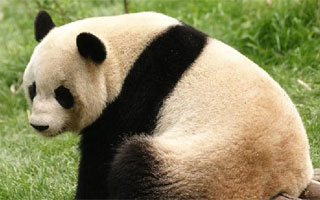
DAY 4 Temple of Heaven + Hongqiao Market + Beijing Olympic village + Gubei Water Town (L)
This morning, we will set out early morning to Temple of Heaven which is the grandest cult architecture complex in the world and a masterpiece of the Chinese people created in ancient times. We could see lots of people do morning exercise there, especially old people practicing Taiji there. It covers 2,700,000 square meters (667 acres), which is nearly four times the area of the Forbidden City. Then visit Hongqiao Market. Hongqiao Market is established in 1979 and stand opposite to the Temple Heaven. It is famous for its various goods, reasonable price, satisfactory service, and good reputation, the most important that the pearls and aquatic products are worldwide famous. After lunch, we drive to Olympic Village (Bird Nest & Water Cube included). Then transfer to Gubei Water Town which will take us almost 2.5 hours. Then we will enjoy a quiet night in Water Town. Overnight in a lovely courtyard folk-style guesthouse with comfort.
Gubei Water Town is situated in Gubei Township of Miyun County northeast of Beijing, hence the name of Gubei Water Town. It has a charming location with a massive backdrop of the world famous Simatai Great Wall, accompany of the romantic Yuanyang Lake (Mandarin Duck) and the ancient Simatai Village that was developed from Simatai Castle built during the reign of Emperor Wanli (1573 -1620) in Ming Dynasty (1368 – 1644). So the Gubei Water Town resort is a rare combo of Great Wall, Mountains, Lakes and Ancient Villages.
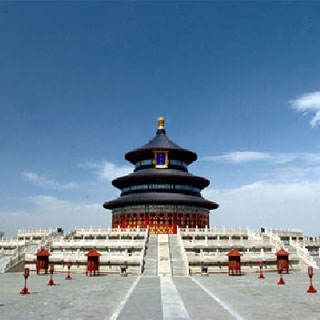
DAY 5 Simatai Great Wall + Gubei Water Town (L)
This morning, we will do a 3hrs round hike on the spectacular Simatai Great Wall. Starting from the bottom of Simatai Great Wall, hike eastward from the Tower One. Our hiking on Simatai stops at Tower where we could enjoy a good view of Jinshanling Great Wall and overlook the surrounding. Then we will down to the bottom of Simatai. After lunch in a local restaurant in Gubei Water Town. We can visit several scenic spots, having the opportunity to participate activities and have experience of Northern China Culture. (We could experience one of the below activities according to our actual time schedule).
Activities in Gubei Water Town:
[Sima Liquor Work Shop] It displays the traditional process of processing liquor. Tourists can have experience of making dishes with rice wine sauce.
[Yongshun Dyeing Shop] It shows the traditional natural dyeing. Tourists can DIY their own products and take them home as gifts for friends.
[Kite Cultural Center] It shows the traditional folk crafts of kite making. Tourists can DIY their own products and take them home as gifts for friends.
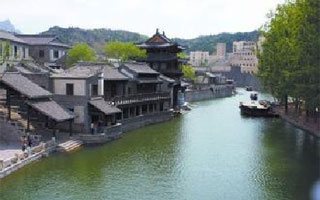
DAY 6 Gubei Water Town - Beijing airport - Lhasa (CA3916, 12:35-17:00) (L)
This morning, we will have a leisure time in the newly built water town. After that it we leave Gubei Water Town and drive directly back to Beijing airport. Take flight to Lhasa. After arriving Lhasa. Meet and greated by your local guide and driver. Transfer to the hotel for a good rest. Stay in comfortable hotel in the center of the old town.
DAY 7 Lhasa (L)
Since we have just made a sudden ascent from lowland to an altitude of over 3,700 meters (12,139 ft), today's itinerary is not so tight. Visit Drepung Monastery, Sera Monastery, and Norbulingka. Drepung is about 8km west of central Lhasa, once world's largest monastery with about 10,000 monks. This day's sightseeing begins with these white monastic buildings piled up on the hillside. Walking up to the hill is a pleasant thing, an easy break from the solemn ambience inside the halls and chapels. At the plat roof of hillside, you can have very good views of the whole Lhasa city and the distant mountains. Sera Monastery sits at the foot of the mountains. One of the three main Gelupka monasteries in Lhasa, Sera is an important spiritual center for Buddhist monks. If we are lucky enough, we could watch the Lamas in their traditional theological exercise of lively debating. Norbulinka (the summer palace of dalai lamas):"Norbu Linka" means beautiful gardens. This garden covers an area of 36 hectares and it is the annual vacation home for the 7th to the 14th Dalai Lama, who would move here from the Potala Palace to this summer palace and spend most of their summer here. Stay in the same.

DAY 8 Lhasa (L)
We will visit the Potala Palace, landmark of Lhasa and spiritual symbol of Tibet - you will join many pilgrims on your way to the top of a hill where this 13-storey architectural wonder is perched upon. The approach to the Potala is not easy, and requires climbing many steep steps, so we take it slowly and allow ourselves to leisurely enjoy the Palace and its surroundings. We enjoy strolling through its winding corridors and peaking in some of its thousand rooms, and can only imagine what life here was once like. In the afternoon, we visit the Jokhang Temple, the spiritual center of Lhasa. As we make the inner circuit around the courtyard, spinning numerous prayer wheels as we go, we are swept up in the energy of the devout. From the rooftop, we get stunning views of the Potala, and the snow capped peaks off in the distance. Around the Temple runs the Barkhor, a holy circuit which pilgrims undertake and a bustling commercial market. The rest of the time is left free for you to venture around Bakhor market, where you will feel you are right at the heart of Tibet. Stay in the same.
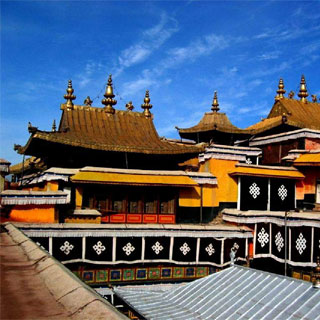
DAY 9 Lhasa - Gyantse - Shigatse (LD)
Drive from Lhasa to Gyangtse (3,950 m or 12,956 feet) and Yamdrok Tso Lake (4408 m),one of Tibet's three holy lakes and located 110km outside of Lhasa. It takes three and a half hour to Yamdrok Tso Lake, most of the time we are driving on the mountain road, winding and bumpy. Far in the distance is the huge massif of Mt. Nojin Kangtsang (7191m). At arrival at Gyantse visit the Pelkor Chode monastery and its associated Kumbum (three dimension mandala) temple. Gyantse is a relaxed town offering a splendid sight of the Kumbum Stupa situated at its Northern edge. Housed within the compound of a rather barren looking Pelkor Chode Monastery, Kumbun consists of 8 levels and a total of 75 chapels with wonderful murals revered by art scholars around the world. Drive back to Shigatse. It would be a long day for about 10 hours. Overnight at Shigatse.
DAY 10 Shigatse - Lhasa (L)
Today we will visit Shigase---the second largest city in Tibet. We will have enough time t explore the Tashilhumo Monastery, the seat of Panchen Lama built in 1447. The monastery houses a giant statue of the Maitreya Buddha and a tomb of the 4th Panchen Lama containing masses of jewels and gold. Then drive back to Lhasa. Tibetan dinner with dancing and singing. Stay in hotel.
DAY 11 Lhasa-Beijing (CA4126 09:30-13:20)
In the morning, transfer to the airport, fly to Beijing. The end of the tour.
Climate
In fact, the Tibetan climate is not as harsh as many people imagine it to be. It is suitable for travel to Tibet from April to the beginning of November, and the best time is August and September.
Sun radiation is extremely strong in Tibet. The sunlight in Lhasa is so intense that the city is called Sunlight City. The thin air can neither block off nor retain heat so that the temperature extremes can be met in daytime and the same night respectively in Tibet.
Most annual rainfall comes in the rainy season that starts from June to September. Usually it rains at night in Lhasa, Shigatse and Chamdo area. The rainfall may block roads and make travel difficult but the scenery at the time will be the best.
The ultraviolet ray is always strong there. You are supposed to bring clothes of three seasons (spring/summer/Autumn) and protect yourself from wind, rain, coldness and sunstroke. Down coat is necessary for those who would like to go beyond Lhasa and Shigatse to remote areas, the Everest Camp for example.
Necessities
Enough films and batteries, Sun-cream with the protection index of 40-60, sunglasses with a sun protection factor of 15, the lip creams and balms with SPF rating, towel, toothpaste, electric torch, Snack foods.
Cloth that you bring must be warm enough and can be removed easy enough according to the weather, including Jacket, Sweater, Headwear, Scarf, Mittens or gloves, Bandanna or handkerchief, Cotton underwear, Socks, Long-sleeve Shirts, T-shirts and Pants (Shorts are not appropriate at any time while hiking), comfortable shoes, rain gear (long rain coat is better).
Medicine
In addition to the normal medications for traveling, just like the Aspirin and medicine for diarrhea, siriasis,sunstroke and carsickness, you should bring some High Altitude medication as you are supposed to trek in the area over 3,000m. The "Acetazolamide" is ten tablets to prevent symptom of acute mountain sickness, or you can ask your local doctor for suggestions.
Currency to use
US$ is acceptable only in a very limited range, e.g. tips. However, for convenience, Chinese currency is the best choice. If you want to change US$ to Chinese currency in the tour, you can change it in the Hotel you stay or in the Bank of China. You could draw cash only from Bank of China in the big city, the ATM there doesn't always work properly and the bank is not easy to find. Please bring some cash at hand to use.
Shopping and night market
Be cautious : Things sometimes get weird late at night when the locals are a little bit too drunk. Many small restaurants and street stalls serve a variety of local delicacies in the night market, but the sanitation condition of the food is not so good!! Take good care of your belongings!!! Never go to the night market alone!!!
Tourist insurance
It is a must before going, please provide us the confirmation of insurance company when sign up.
Tibetan people
They are very kind and hospitable. You can feel free to talk with them. But there are some rulers you should go by:
Do not photo them without permission, please show the respect to them!
Do not talk about the sensitive topics like political or t religious matters!
Do not eat dog, donkey or horse in Tibet!
What can I do with Tibetan beggars?
Religious beggars are an accepted part of society in Tibet. Giving money or food to a pilgrim is considered an act of merit, donations of five fen to two jiao (Chinese money) are appropriate. Notice if the beggars are the old men and women who dress in shredded, bulky clothing, while the Younger ones may have a monkey on a chain, a spectacle of great interest to the Tibetans. These beggars are professionals, having less meritorious intentions than religious pilgrims. Just wave them off as the locals do if you don't want give anything.
Always take good care of your belongings.

